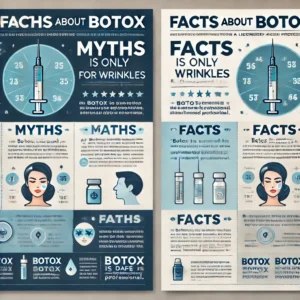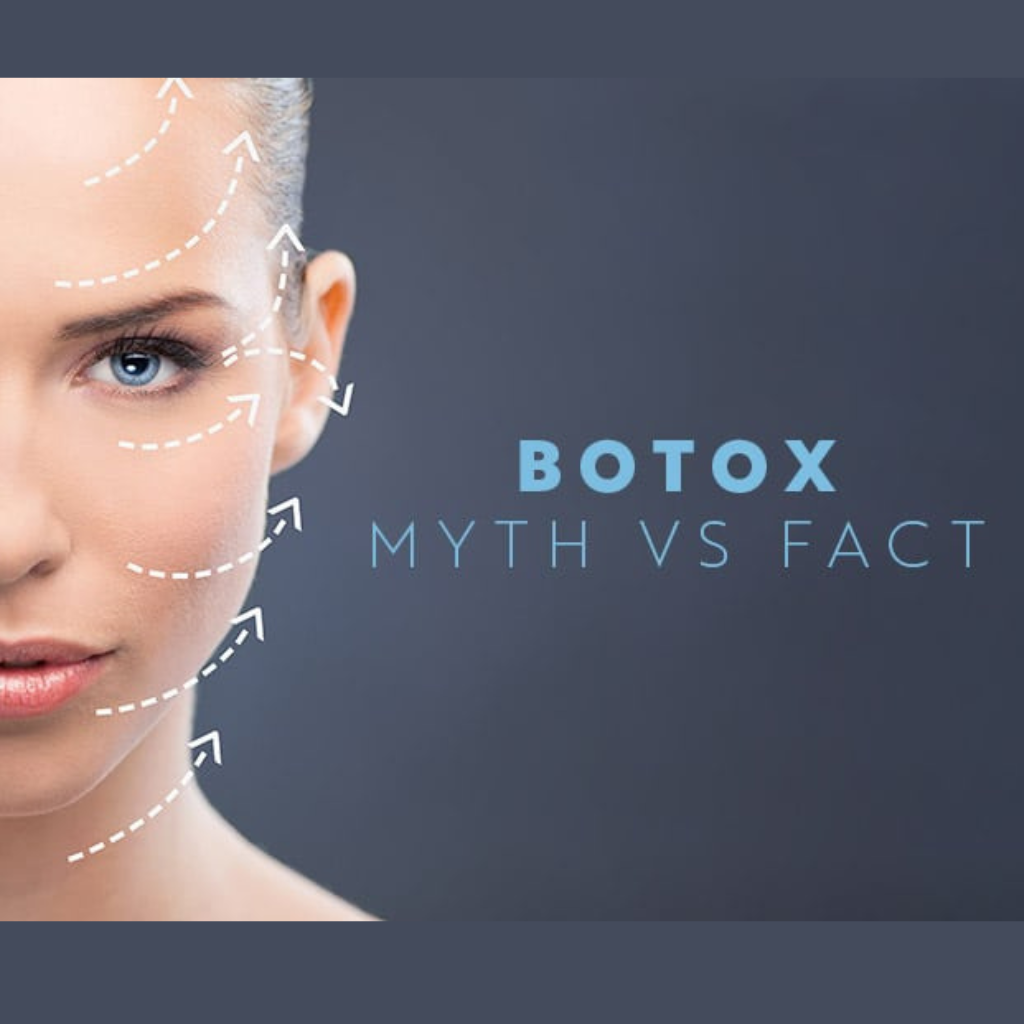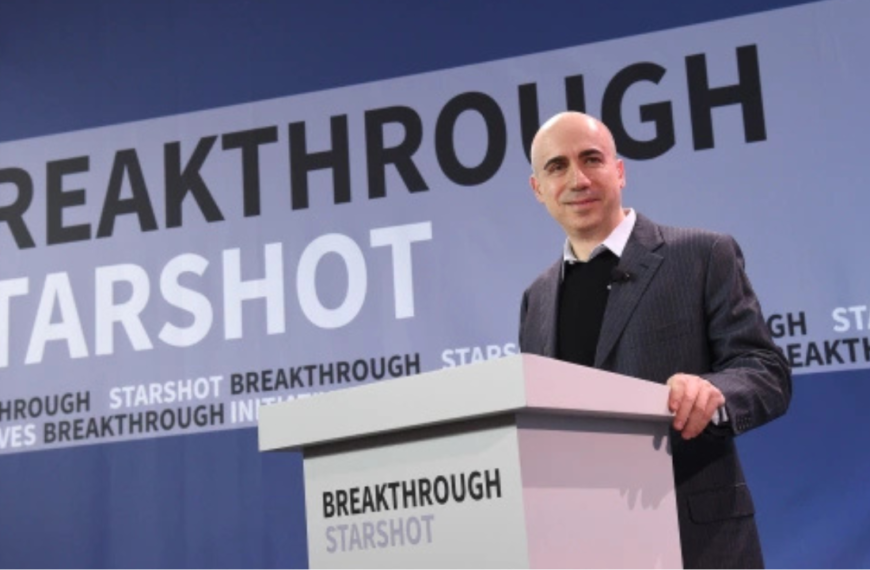Botox has become one of the most widely recognized names in the world of cosmetic treatments, particularly for its ability to smooth wrinkles and fine lines, giving individuals a more youthful appearance. What started as a medical treatment for conditions like muscle spasms and excessive sweating has evolved into a go-to solution for non-surgical aesthetic procedures. Today, millions of people around the world use Botox to reduce the visible signs of aging, such as crow’s feet, forehead lines, and frown lines.
However, despite its widespread popularity and proven effectiveness, there is still a great deal of misinformation surrounding Botox. Some people are hesitant to consider Botox due to misconceptions about its safety, effectiveness, or even its applicability to different age groups. That’s why it’s crucial to separate the facts from the myths when it comes to Botox. By understanding the truth behind this cosmetic treatment, you’ll be better informed about its potential benefits and risks, allowing you to make an educated decision if you’re thinking about trying Botox for yourself.
We’ll explore both the facts and the myths about Botox. From its medical applications to its ability to improve facial aesthetics, we’ll clear up common misunderstandings and provide you with a complete picture of what Botox can—and cannot—do. Whether you’re considering Botox for the first time or simply want to learn more about this popular treatment, this guide will equip you with the knowledge to make an informed choice.
What Is Botox?
Botox, a brand name for botulinum toxin, is a well-known injectable treatment that temporarily reduces the appearance of facial wrinkles and lines. It is derived from the botulinum toxin, which is produced by Clostridium botulinum, a bacterium. Though the toxin in its natural form can cause botulism, Botox is used in very controlled, diluted doses, making it safe and effective when administered by a trained professional.
The treatment works by acting as a muscle relaxer. When injected into targeted areas of the face, Botox temporarily blocks the nerve signals responsible for muscle contractions. This means that the facial muscles relax and cannot contract as strongly, smoothing out the skin and reducing the appearance of wrinkles. It is particularly effective in areas where facial expressions cause lines to form, such as around the eyes, forehead, and between the eyebrows.
FDA Approval and Safety of Botox
Botox was first approved by the U.S. Food and Drug Administration (FDA) in 2002 for cosmetic use, specifically for treating moderate to severe frown lines between the eyebrows. Since then, it has gained FDA approval for several other cosmetic applications, such as treating crow’s feet and forehead lines. Botox is also approved for numerous medical uses, including managing chronic migraines, excessive sweating (hyperhidrosis), and certain muscle disorders.
Botox has undergone extensive testing and clinical studies, which have affirmed its safety and efficacy when used as directed by healthcare professionals. The treatment is considered minimally invasive, with very few side effects, most of which are mild and temporary. Additionally, Botox has been used safely for over two decades, with millions of people benefiting from the treatment worldwide.

How Botox Works to Reduce Wrinkles
The key to Botox’s effectiveness lies in its ability to block nerve signals to muscles. Normally, when you make facial expressions such as raising your eyebrows or squinting your brain sends signals through the nerves to the muscles in your face, causing them to contract. These repeated muscle contractions, over time, contribute to the development of wrinkles and lines.
When Botox is injected into the targeted muscle, it temporarily disrupts the transmission of these nerve signals. As a result, the muscle relaxes, reducing its ability to contract. The skin above the muscle, no longer being pulled by repeated contractions, begins to smooth out. This helps to soften the appearance of existing wrinkles and prevent new ones from forming. Botox typically starts showing visible results within a few days, and the effects can last anywhere from three to six months, depending on the individual and the area treated.
The beauty of Botox lies in its precision. It targets specific muscles responsible for wrinkles, leaving the rest of the facial muscles unaffected. This allows for natural-looking results that preserve your ability to express yourself while reducing the appearance of unwanted lines.
Botox Facts
Non-Surgical Anti-Aging Treatment
Botox is widely known for its role as a non-surgical solution to combat the visible signs of aging. Unlike invasive procedures such as facelifts, Botox offers a minimally invasive alternative that requires no incisions, stitches, or long recovery periods. This makes it an appealing option for individuals seeking facial rejuvenation without the risks and downtime associated with surgery.
How Botox Helps Reduce Facial Lines and Wrinkles
Botox works by temporarily paralyzing specific facial muscles responsible for wrinkle formation. Over time, as we age, our skin loses elasticity, and repeated muscle contractions (like frowning, squinting, or raising eyebrows) create permanent lines and wrinkles. Botox addresses these lines by inhibiting the nerve signals that trigger muscle contractions, allowing the muscles to relax and the skin to smooth out. The result is a more youthful, refreshed appearance with softer, less noticeable wrinkles.
Areas of the Face that Botox Targets
Botox is effective in treating several areas of the face where wrinkles tend to form due to facial expressions. These areas include:
- Forehead lines: Horizontal lines that appear when raising your eyebrows.
- Crow’s feet: Fine lines that form around the outer corners of the eyes due to squinting or smiling.
- Frown lines: Vertical lines that develop between the eyebrows from repeated frowning or scowling.
- Bunny lines: Wrinkles that appear on the sides of the nose when scrunching the face.
- Neck bands: Botox can also be used to treat visible bands in the neck caused by muscle contraction.
Targeting these areas with Botox can smooth out existing lines and prevent new ones from forming, providing a more youthful and relaxed appearance.
Botox as a Preventative Treatment
While Botox is often used to treat existing wrinkles, it can also be a highly effective preventative treatment for those looking to avoid the development of deeper lines and wrinkles. In younger individuals, Botox can be used before deep wrinkles form to prevent the overuse of certain muscles, which can lead to wrinkle formation in the first place. This is why some people in their late 20s and early 30s choose Botox as a proactive step in their skincare routine.
Smoothing Existing Wrinkles and Preventing New Ones
Botox not only smooths out current wrinkles, but it can also work as a preventative treatment. By relaxing the muscles responsible for wrinkle formation, Botox prevents them from further deepening. The result is smoother skin and a reduction in the visible appearance of fine lines and wrinkles over time. Regular Botox treatments can maintain these effects and contribute to long-term prevention.
Importance of Multiple Sessions for Optimal Results
While Botox can make an immediate difference in the appearance of wrinkles, achieving optimal, lasting results often requires multiple sessions. Most individuals will notice significant improvement after one or two treatments, but the full effects are often seen after 2-3 sessions. Botox typically lasts for 3 to 6 months, depending on the area treated and the individual’s muscle activity. To maintain the youthful look, treatments need to be repeated regularly. Over time, some people find that they require fewer injections as Botox helps to prevent the deepening of wrinkles.
Medical Benefits Beyond Aesthetics
In addition to its cosmetic benefits, Botox has proven to be an effective treatment for several medical conditions. It is widely used in the healthcare field for its ability to block nerve signals and relax muscles. Some of the medical uses of Botox include:
- Chronic Migraines: Botox has been FDA-approved for the prevention of chronic migraines. It works by blocking the release of certain chemicals involved in the pain process, helping to reduce the frequency and severity of headaches.
- Excessive Sweating (Hyperhidrosis): Botox is an effective treatment for hyperhidrosis, a condition that causes excessive sweating in areas such as the underarms, hands, feet, and face. By blocking the nerves responsible for sweat production, Botox can significantly reduce sweating.
- Cervical Dystonia: This neurological condition causes abnormal neck muscle contractions, leading to neck pain and abnormal postures. Botox can be used to relax the muscles and relieve the symptoms of cervical dystonia.
- Bladder Dysfunction: Botox injections are also used to treat overactive bladder, a condition that causes frequent, urgent urination. By relaxing the bladder muscles, Botox helps reduce these symptoms and improve quality of life.
These medical uses highlight the versatility of Botox beyond its aesthetic applications, offering relief to individuals suffering from chronic conditions that may otherwise be difficult to treat.
Quick and Convenient Procedure
One of the most appealing aspects of Botox is its quick and convenient procedure. Botox treatments typically take only 10 to 30 minutes, depending on the area being treated. The procedure is performed in a doctor’s office or clinic, and no hospitalization is required. Additionally, Botox injections involve little to no downtime—most individuals can resume normal activities immediately after the procedure.
There’s no need for anesthesia or extensive recovery time, making Botox an ideal option for individuals with busy schedules. The injection itself is minimally painful, often described as a slight pinch or a brief sting. For those who are concerned about discomfort, topical anesthetic creams can be applied prior to the treatment to numb the area.
With no extensive recovery period, Botox is often referred to as a “lunchtime procedure,” allowing individuals to get the treatment during a break and continue with their day as usual. The convenience and ease of the procedure, along with the minimal side effects, contribute to Botox’s popularity among those seeking a safe, effective, and hassle-free solution for facial wrinkles.
Common Myths About Botox
Only Women Can Get Botox
A prevalent myth surrounding Botox is that it is exclusively for women. However, Botox is just as effective for men as it is for women. Wrinkles and facial lines are a natural part of the aging process for both genders. As both men and women age, their skin loses elasticity and fine lines develop, often around the eyes, mouth, and forehead. Botox can be used by men to treat these areas and achieve a more youthful, refreshed appearance, just as it does for women.
The use of Botox by men has been increasing in recent years, with more men seeking Botox to reduce signs of aging without the need for invasive procedures. The treatment can address wrinkles and fine lines effectively, regardless of gender. Botox is tailored to meet the individual needs of each person, regardless of whether they are male or female.
Botox Is Dangerous
Many people are concerned about the safety of Botox, often assuming it could be harmful or toxic. However, this is far from the truth. Botox has been FDA-approved for cosmetic and medical uses for over 20 years, with an extensive history of safe application. When performed by a licensed, experienced professional, Botox treatments are safe and well-tolerated by most individuals.
Botox is made from botulinum toxin, which sounds alarming, but in the small, controlled doses used in Botox injections, it is not toxic. The botulinum toxin is used in a way that temporarily paralyzes muscles to smooth out wrinkles without affecting other body functions. Thousands of Botox treatments are administered worldwide each day, and the procedure has been shown to be safe when used correctly.
The misconception that Botox is dangerous likely stems from its association with botulinum toxin, but the safety of Botox has been consistently proven. Side effects, if they occur, are usually minor and temporary, such as mild swelling or redness at the injection site, and serious complications are rare.
Botox Injections Are Painful
Many individuals fear that Botox treatments will be painful, but in reality, the procedure is relatively comfortable for most people. The needle used for Botox injections is very fine, and the process typically causes only minimal discomfort. Most patients report that it feels like a small pinch or sting, similar to receiving a flu shot or a blood draw. The procedure usually takes only 10 to 30 minutes, and many people tolerate it with little to no discomfort.
For those who are sensitive to pain or discomfort, an anesthetic cream can be applied to the treatment area prior to the injection. This numbing cream further minimizes any discomfort during the procedure. Afterward, there is generally no significant pain, and you can return to your normal activities immediately. Botox treatments are designed to be quick, easy, and with minimal pain, making them a popular choice for those seeking a non-invasive anti-aging solution.
Botox Is Only For Older People
Another common misconception is that Botox is only for older individuals, typically those in their 50s or 60s. In fact, Botox is FDA-approved for individuals aged 18 to 65, and it can be an effective treatment for individuals of various age groups. While many people think of Botox as a remedy for existing wrinkles and signs of aging, it can also serve as a preventative measure.
For younger individuals, Botox can be used in their late 20s or early 30s to prevent the development of deep lines and wrinkles in the future. Wrinkles often begin to form as collagen production decreases in our 20s, and Botox can help slow this process by relaxing the muscles responsible for wrinkle formation. Using Botox earlier can prevent the lines from becoming deep-set, helping to maintain smoother skin for years to come.
The Bottom Line: Botox Is Safe and Effective
Botox has firmly established itself as one of the most popular and effective non-surgical treatments for reducing the appearance of wrinkles and fine lines. It works by temporarily relaxing the facial muscles responsible for causing these imperfections, providing smoother, younger-looking skin. The benefits of Botox extend beyond aesthetics, offering medical applications for conditions such as chronic migraines, excessive sweating, and more. Its FDA approval and a long history of safe use make it a trusted solution for millions of people around the world.
While myths and misconceptions about Botox continue to circulate, it’s clear that these are largely unfounded. Botox is not just for women, it is not dangerous, it is not painful, and it is not only for older people. Men and women alike, regardless of age, can benefit from Botox as part of their skincare and wellness routine. The treatment is quick, minimally invasive, and requires no downtime, which is a major draw for individuals with busy schedules who still want to maintain a youthful appearance.
The growing popularity of Botox can be attributed to its impressive safety profile, the noticeable improvements it offers, and its ability to prevent future wrinkles from forming. Botox provides individuals with a non-invasive, highly effective option to combat the signs of aging, contributing to its continued rise in popularity among people of all ages.
Read more: Birthstones: Do you know yours?
conclusion
Botox remains a safe, effective, and convenient solution for those looking to improve their appearance and address specific medical conditions. Whether you are considering it for aesthetic reasons or medical treatment, Botox continues to be a reliable and popular choice for many. The key to its success lies in its combination of safety, convenience, and long-lasting results. So, if you’re thinking about Botox, there’s no reason to be apprehensive. It remains one of the best options for achieving a more youthful, refreshed look.

















